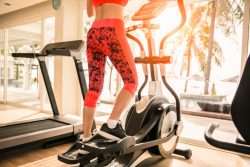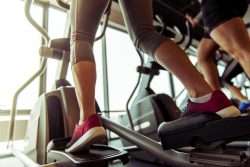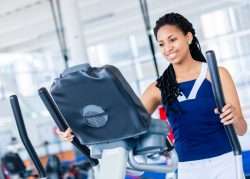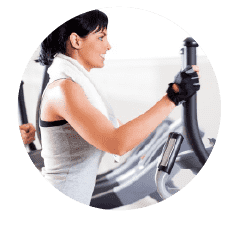What Muscle Groups Do Elliptical Machines Target?
If you’re about to embark on an elliptical training regime, you may be wondering which muscle groups you’re going to be working. Which muscles will be targeted when doing this type of exercise and how can that help you overall with your fitness pursuits as well as day to day life?
The great thing is that the elliptical trainer really is a full body workout, targeting just about every single major muscle group while you perform it. This means that you don’t necessarily have to perform additional training on top of your elliptical sessions if you don’t want to.
This said, do keep in mind that you may wish to add weight lifting to your plan as well because as far as building functional strength goes, weight lifting is king. Elliptical training is great for building cardiovascular fitness and muscle endurance, but you simply won’t get as strong doing it as you would if you were to do say a heavy set of squats, lunges, or the bench press.
This said, let’s look at the many different muscles that the elliptical machine targets so that you can quickly see why it’s one you’ll want to try out.
Muscle: Quads
The first major muscle group you’ll work when using this machine is the quads. This is the muscle that runs from the front of your hip down to your knee and forms, for most people, the greatest overall muscle in the legs.
How It’s Worked:
You’ll work your quads on the elliptical each and every time you transfer your weight and then push the pedal down. Therefore, one of the best ways to target the quads to a higher degree while using the elliptical is to set the elevation at its highest level.
The higher the elevation goes, the more quad muscle action will be required to ‘climb’ you up to that height.
If you wish to put less emphasis on the quads, then instead, you’ll want to lower the incline so that you aren’t stepping up as much with each stride you do.
Fitness Benefits:
The nice transfer over benefits you’ll experience from gaining strength in your quads is you’ll be better prepared to perform most all lower body strength training movements – squats, lunges, split squats, and leg extensions.
If you also bike as a means of cardio training, you’ll notice transfer over benefits there as well because the quads power you through the movement cycle required by this mode of exercise.
Lifestyle Benefits:
Finally, in terms of lifestyle, your quads are heavily at work each and every time you climb up a flight of stairs or sit down or get up from a chair seat. So as you get stronger quads, you’ll notice these everyday movements getting easier.
Muscle: Hamstrings

The hamstrings are located on the back of the leg, directly opposite of the quads. They run from the glutes (muscles that form the bum) down to the knee joint.
How It’s Worked:
The hamstrings are going to be worked with each movement cycle that you do as well. They are going to be helping to press the pedal downward, returning to the starting position.
If you want to put more emphasis on the hamstrings while doing the elliptical trainer, one great thing to do is to actually do it in reverse. This movement pattern completely changes the nature of the exercises it a more hamstring predominant rather than quad dominant movement.
Fitness Benefits:
The hamstring muscles as well will help you complete traditional lower body weight lifting moves including the squat and lunge. In addition to that, they are also critically important for doing the deadlift, which is another primary strength building exercises.
The hamstrings will also help you out when cycling or uphill walking, so if you do either of these as part of your fitness routine, expect to see carry over benefits.
Lifestyle Benefits:
Finally, the hamstrings also help you get up from a chair and they help assist with walking down the stairs especially, so are also needed every single day. They’ll also come into play slightly if you bend over at the waist and then straight up again, so that is another time you might find yourself using this muscle.
Muscle: Calves

How It’s Worked:
The calves contract in coordination with the quads and hamstrings while on the elliptical, each and every time you step up.
In addition to that, they are also going to act as stabilization muscles, keeping your entire body stabilized as you do the movement pattern.
The calf muscle is typically not one to get very large, but it can be quite powerful because it’s constantly being used to keep the body standing and upright.
Fitness Benefits:
Having strong calves is like the icing on the cake. It’ll help ensure that your weakest link isn’t calf endurance and it can also help to strengthen your ankles, making an ankle injury less likely.
Lifestyle Benefits:
Since the calves contract whenever you take a step forward, having stronger calves and calves that have better endurance will mean you won’t fatigue as fast when walking in day to day life. It’ll also help give you a boost any time you want to climb stairs as the primary purpose of the calf is to elevate the body onto the toes.
Muscle: Glutes
Located in the bum region at the top of the leg, the glutes are the fleshy muscle group that so many people want to build in today’s times.
How It’s Worked:
The glutes are heavily used whenever you move from a seated to a standing position as they work in conjunction with the hamstrings and quads to push the leg down. The glutes are also involved in stair climbing, helping to propel the body upward.
Fitness Benefits:
The stronger your glutes are, the easier those squats, lunges, deadlifts, or any other lower body movement will be. The glutes help out in almost all fitness pursuits except any exercise that has you sitting or doing strictly upper body activity.
Lifestyle Benefits:
The glutes are going to be heavily involved while standing, therefore this benefit will transfer over to just about everything you do.
Muscle: Core

How It’s Worked:
The core is not worked directly while using the elliptical trainer, but rather worked indirectly as it helps you maintain stabilization as you go about the movement.
Fitness Benefits:
Because a strong core is the foundation of just about every single fitness activity you do, having a strong core will carry over, helping you be stronger in everything else. In addition to that, it it can also help reduce your risk of injury.
Lifestyle Benefits:
A strong core is vital to maintaining good posture, preventing back pain, and avoiding injury. It’s also going to help keep you looking slimmer, so may assist with your weight loss goals.
Muscle: Back
The back muscles run all along the back of the body and are a major muscle group consisting of many smaller muscles.
How It’s Worked:
When you perform the elliptical, the back muscles will be used to pull the handle bars towards the body, doing so on every single rep you take.
Also called into play here are the biceps, which act synergistically with the back to pull the bars toward you. The biceps run along the top front portion of the arm and are the main muscle involved when you do a flex pose with the upper body.
Fitness Benefits:
A strong back helps build an overall stronger physique and will help give you that V-taper that makes your waist look slimmer. It’ll help you perform exercises like bent over rows, pull-ups, and any other type of pulling movement with ease.
Lifestyle Benefits:
Every time you open a door, you use your back muscles, so you can imagine how having stronger back muscles would make things easier. A strong back is also important for keeping the body upright and assisting in postural control.
Muscle: Chest And Front Delts
The chest and front delts are located in the front of the body and oppose that of the back. They are responsible for pushing, while the back is responsible for pulling.
How It’s Worked:
When doing the elliptical, each time you push the handle bars forward, you will engage your chest and front delts. Also called into play at this time will be the tricep muscles, which sit on the upper back portion of the arm and are responsible for helping the shoulders as well as for extending the elbow.
Fitness Benefits:
A strong chest and front delts will help you out with any type of shoulder pressing activity as well as any push-ups, bench press, or incline press. The triceps are also involved in all of these muscles, so will come into play as well.
Furthermore, the triceps, not the biceps, actually make up the largest part of the arm so building stronger triceps will help your arms look that much more toned.
Lifestyle Benefits:
As you go about your day, your chest and front felts will help you push open doors, lift things to a higher level, and help to maintain good posture. Stronger arms are also going to be helpful for lifting any object you desire, so will really come in helpful as you go about your various tasks.
So as you can see, the elliptical is a highly beneficial piece of equipment to use and will be a great addition to anyone’s workout routine.
Photo credit: George Rudy/Shutterstock; Dan76/Shutterstock; oscarhdez/Shutterstock



 Compact/Folding
Compact/Folding Front Drive
Front Drive Rear Drive
Rear Drive